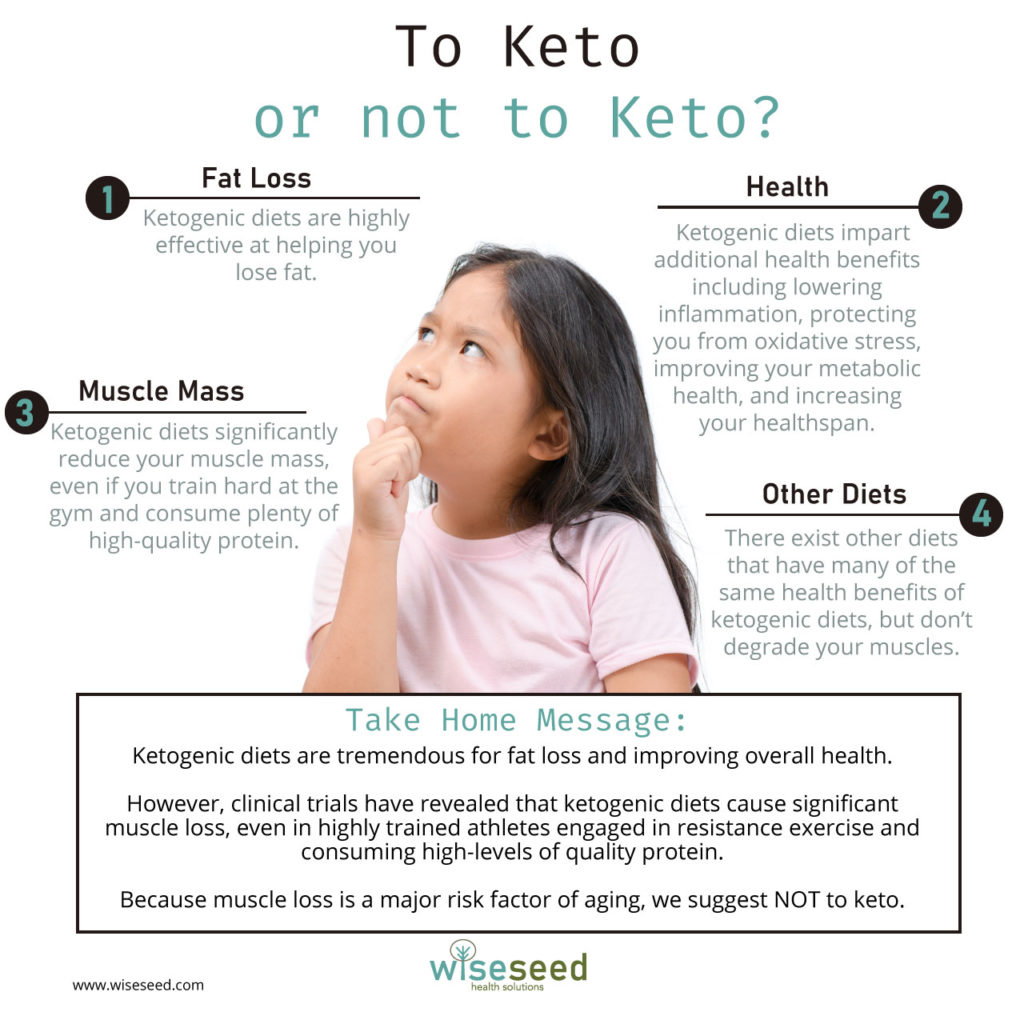To Keto or not to Keto?

Setting the scene.
The internet is flooded with articles about which dietary approach is best. As a result, it’s all too easy to commit to a diet that is promoted by someone you follow online. I know because this happened to me with the ketogenic diet!
To Keto!
The people I follow are extremely competent, so when some of them promoted the ketogenic diet, I took them seriously. Because I was a bit chubby, I thought, what the heck! I’ll keto it up, increase my conditioning, and I should drop the weight.
And it worked! Simply by cutting almost all carbohydrates out of my diet, I lost 1-2 kg a week. In no time I’d lost 15 kg and I was leaner than I had been in years.
Whoops… not to Keto!
I did, however, experience two major problems while going keto. First, I lost muscle. Because I was still lifting weights and eating plenty of protein, I assumed that I’d hang on to my muscle. Wrong! I lost heaps of muscle and became much weaker. Initially, I blamed this on too much cardio, so I switched back to my usual routine. Alas, I stayed weak and skinny.
The second problem was that when I performed any form of high-intensity interval training, be it sprints or hitting the heavy bag, I would suddenly run out of gas. And I don’t mean that I was merely fatigued. I hit the wall, game over.
To summarize my experience of the ketogenic diet, it was a fantastic approach for losing fat, but it destroyed my physical performance. For me, the keto juice was not worth the squeeze.
A new study examining the effect of ketogenic diets in people who lift weights.
Until recently, I assumed that I had either messed up the ketogenic diet, or that I’m a type of human who needs carbs for optimal performance. However, a timely meta-analysis recently published by Ashtary-Larky and Colleagues 1 provides some compelling data that supports my overall negative view of the ketogenic diet. As a result, I’m formally coming out of the anti-keto closet and stating for the record that ketogenic diets suck.
What is a ketogenic diet?
Put simply, a ketogenic diet is a low-carbohydrate, high-fat, and moderate-to-high protein diet. The bulk of your energy (60-80%) comes from consuming fats, with carbohydrates only supporting around 5% of your daily energy needs. Your protein intake is set to 1.2 – 1.5 g of protein/kg of bodyweight/day.
If executed correctly, a ketogenic diet will push your body into a state of ketosis. Ketosis lowers your blood glucose levels while increasing the concentration of ketone bodies in your blood. Ketone bodies, in particular the ketone body β-hydroxybutyrate, provide an alternative source of energy for the cells of your body, in particular the energy-demanding cells of your brain and heart 2.
Importantly, many studies have demonstrated that ketogenic diets are superior to traditional, low-fat diets at reducing body fat 3. Moreover, there is considerable evidence that β-hydroxybutyrate reduces inflammation, decreases oxidative stress, and possibly even extends your healthspan 2. Finally, ketogenic diets have been shown to reverse metabolic syndrome 4 and improve type 2 diabetes 5. Thus, ketogenic diets impart multiple health benefits in addition to fat reduction.
What the researchers did.
One potential pitfall of ketogenic diets is that they have the capacity to stop muscle growth and promote muscle breakdown 6. In contrast, weight training is a proven method to increase muscle growth and decrease muscle breakdown. Thus, combining weight training with a ketogenic diet may allow you to shed fat whilst simultaneously building muscle.
To see whether this dream hypothesis was supported by actual data, Larky and Colleagues scoured the internet for clinical trials that combined resistance training with a ketogenic diet 1. They found 13 studies suitable for further meta-analysis 1. Of note is the wide range of people who participated in these trials. Studies were performed in overweight females, males with metabolic syndrome, elite artistic gymnasts, Taekwondo athletes, CrossFitters, resistance-trained males and females, intermediate to elite competitive lifting athletes, healthy adults from various military branches, and untrained adults 1.
What the researchers found.
The good news is that people who were both on the ketogenic diet and performed weight training showed significant improvements in fat loss, body fat percentage, and body mass index (BMI) compared to those people who only performed weight training 1. These findings support historic studies that first revealed ketogenic diets as a highly effective diet for reducing body fat 3.
And now for the bad news. Despite the study participants performing resistance exercise and consuming adequate-to-high levels of protein, those who were put on a ketogenic diet lost a significant amount of lean muscle 1.
Thus, ketogenic diets cause significant muscle loss, which is NOT prevented by the combined anabolic stimuli of resistance training plus high protein intake 1.
Why this really sucks for older adults.
Unfortunately, one of the hallmarks of aging is the progressive loss of muscle that occurs independently of health status 7. Muscle loss occurs at a rate of approximately 0.5 – 2% per year after the age of 50 8. If left unchecked, this age-related muscle loss will significantly compromise your strength, endurance, and overall physical performance 9. For this reason, I believe that it’s a bad idea for older adults to further increase their rate of muscle loss by going on ketogenic diets.
The Take Home Message
On the one hand, ketogenic diets are a proven approach for rapid fat loss, and they have additional health benefits such as reducing inflammation, protecting you from oxidative stress, improving your overall metabolic health, and increasing your healthspan. On the other hand, ketogenic diets cause significant muscle loss, even if you train hard at the gym and eat plenty of protein.
Fortunately, other diets (such as the Mediterranean Diet) have similar health benefits compared to ketogenic diets, without the downside of putting you into starvation-mode and degrading your muscle mass. Therefore, my personal preference is to use diets that include enough carbohydrate to maintain your muscle mass during periods of fat loss.
Nevertheless, the many health benefits of ketogenic diets are impossible to ignore. My hope is that exercise and nutrition researchers will develop optimal feeding-fasting protocols that provide all the health benefits of ketogenic diets, without the downside of losing precious muscle.
Please click on the link below to download your free PDF.

References and Further Reading
1 Ashtary-Larky, D. et al. Effects of resistance training combined with a ketogenic diet on body composition: a systematic review and meta-analysis. Crit Rev Food Sci Nutr, 1-16, doi:10.1080/10408398.2021.1890689 (2021).
2 LaFountain, R. A. et al. Extended Ketogenic Diet and Physical Training Intervention in Military Personnel. Mil Med 184, e538-e547, doi:10.1093/milmed/usz046 (2019).
3 Bueno, N. B., de Melo, I. S., de Oliveira, S. L. & da Rocha Ataide, T. Very-low-carbohydrate ketogenic diet v. low-fat diet for long-term weight loss: a meta-analysis of randomised controlled trials. Br J Nutr 110, 1178-1187, doi:10.1017/s0007114513000548 (2013).
4 Volek, J. S., Fernandez, M. L., Feinman, R. D. & Phinney, S. D. Dietary carbohydrate restriction induces a unique metabolic state positively affecting atherogenic dyslipidemia, fatty acid partitioning, and metabolic syndrome. Prog Lipid Res 47, 307-318, doi:10.1016/j.plipres.2008.02.003 (2008).
5 Hallberg, S. J. et al. Effectiveness and Safety of a Novel Care Model for the Management of Type 2 Diabetes at 1 Year: An Open-Label, Non-Randomized, Controlled Study. Diabetes Ther 9, 583-612, doi:10.1007/s13300-018-0373-9 (2018).
6 Paoli, A., Bianco, A. & Grimaldi, K. A. The Ketogenic Diet and Sport: A Possible Marriage? Exerc Sport Sci Rev 43, 153-162, doi:10.1249/jes.0000000000000050 (2015).
7 Evans, W. J. What is sarcopenia? J Gerontol A Biol Sci Med Sci 50 Spec No, 5-8 (1995).
8 Cherin, P., Voronska, E., Fraoucene, N. & de Jaeger, C. Prevalence of sarcopenia among healthy ambulatory subjects: the sarcopenia begins from 45 years. Aging Clin Exp Res 26, 137-146, doi:10.1007/s40520-013-0132-8 (2014).
9 Mitchell, W. K. et al. Sarcopenia, dynapenia, and the impact of advancing age on human skeletal muscle size and strength; a quantitative review. Front Physiol 3, 260, doi:10.3389/fphys.2012.00260 (2012).

Ten Minutes is All You Need
Research has shown that ten minutes of moderate-to-vigorous exercise performed each day is enough to significantly reduce your risk of early death.





